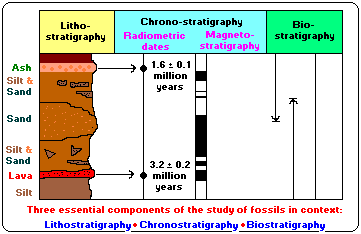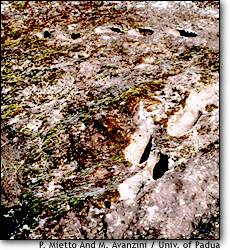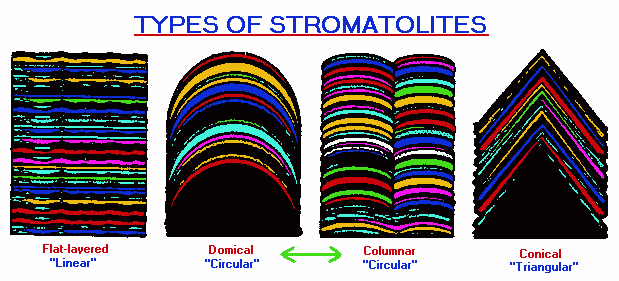Page B
(The Study of Threes)
http://threesology.org
This page is a companion to the following links:
- Evolutionary 3s page A
- Evolutionary 3s page C
- Evolutionary 3s page D
- Evolutionary 3s page E
- Evolutionary 3s page F

It is said that stones tend to appear with rounded edges in nature, which would seem to be easily verified by many a rock thrower. Yet many a person who has ventured their luck in attempting to skip a stone across a lake knows well that they have a slight edge on competing rock skippers if they throw stones which have a thin edge, as opposed to a more rounded or flat side. If we look at a stone from its flat side, it will appear to be rounded even if it has an edge. But if we look at a stone from a side perspective, the thin edge appears as a sort of triangular-shaped tapered surface. Therefore, our descriptions of the shape of a stone are determined by the angle of perspective we tend to indulge in. The frequency with which stones with rounded edges can be found due to the repeated usage of a "flat- sided perspective," assists some researchers in the identification of rocks as being stone tools when they don't have a naturally occurring round edge.
With this thought in mind, one might wish to stray into a more museful consideration of this idea, and ask if this "flat-sided perspective" is a remnant of early peoples' flat-earth perspective, that was itself a symbolic representation of yet an earlier mental impression of a flat-sided view, that was recreated in the fashioning of tools? Whereas some interpreters of stone tools may prefer to consider that a stone tool was used due to some perceived functional utility for a task at hand, which may very well be the case, but we must also consider that a tool's utility may not have been the sole reason for its shape, or why it was repeatedly manufactured. I'm not talking about tools having a secondary usage as an ornament or any other human- related social characteristic, but that there is a tertiary "reason" involving the way genetics was fashioned on this third planet from a source of solar energy. However, it is important to disassociate the word "reason" from the words "purpose" and "intent" that become further extrapolated in the imaginations of some to be interpreted as "intelligent design".
3 common categorizations of whether Stones are tools or not: Doubtful~ Probable~ Definite.
3 flake scars on a questionable stone tool is sometimes regarded as evidence that the artifact in question is an actual specimen due to the idea that successive recurrences are made by a stone tool maker, because succession implies deliberate activity. Stones that are flaked in 3 different directions adds further credibility to claims.
In supporting the views of some claims regarding the antiquity of sites from which stones are found, some researchers suggest that early hominids engaged in a frequent casual usage of available materials to be used as tools, which they discarded afterwards. This reasoning helps to de-emphasize the definition of stone tools as representations of Symmetry~ Refinement~ Systematic continuity in tool types, and emphasizes the idea that early hominids would have used the most convenient means of accomplishing the job at hand.
|
Three essential components for studying fossils in
context: The rock record provides information on: | |
|
 |
| (Chart & information from page 190, Cambridge Encyclopedia of Human Evolution, 1992.) | |
|
- 3 geological system divisions by Charles Lyell: Eocene~ Miocene~ Pliocene
- 3 geological periods: Cenozoic~ Mesozoic~ Paleozoic
- 3 traditional divisions of Geography: Land~ Sea~ Air
Triangulation is the principal method of geometric geodesy for planimetry.
3 (categorical descriptions of) basic stone tools frequently found:
- Used for pounding.
- Used for scraping.
- Used for cutting
3-patterned ideas associated by some researchers to stone tools:
- Angle platform scar (three words used)
- Secondary edge-flaking (three words used)
- Striking platform angle (three words used)
- Light utility~ Medium utility~ Heavy utility
- A striking platform~ Bulb of percussion~ Eraillure
- Bulbs of percussion~ Conchoidal fractures~ Intentional chipping in a determinate direction
- Size~ Shape~ Adaptation to the human hand
3 questions to be answered when considering stone tool implements:
- Is the specimen really of human manufacture?
- Has the age of the stratum in which it was discovered been properly determined?
- Was the implement incorporated into the stratum at the time the stratum was laid down, or was the implement introduced at a later date?
3 conditions which assist in validating the authenticity of stone tools:
- They are found as integral parts of the site.
- They have sharp, well preserved edges, indicating they have not been subjected to transport over extended distances.
- They have a patina (color) similar to the rocks in the strata of which they formed a part.
3-patterned phrases associated with different eras of anthropology:
- homo sapiens sapiens
- norwich test specimen
- definitive debunking report
- greatly augmented evidence
- the (a) human authorship
- facultative terrestrial bipedalism
- (evidence) stands absolutely alone
3 co-authors, in 1985, along with the Anthropologist Della Collins Cook, published a study of the vertebral column of Australopithecus afarensis (another 3 to 1 example).
See web-pages on 3 "to" 1 examples starting here:
http://www.threesology.org/321-a.php
1~ 2~ 3-patterned usage of words describing the ascent of man:
- Apes = 1 word
- Homo erectus = 2 words
- Homo sapiens sapiens = 3 words
***Microliths are very small stone tools, generally 3 cm in length (1.2 inches).
***Facets of fractures on stone tools are sometimes found to be Short ~ Uneven ~ And steeply transverse across the flake edge.
***In 1877, Capellini reported that the marks on the skeleton of the Balaenotus are found on:
- Marine fossil
- Brackish water fossil
- Fresh water fossil.
***Some geological stratifications are said to present evidence of alternating Marine ~ Brackish ~ Fresh water deposits.
3 to 1 division of eras: Cenozoic ~ Mesozoic ~ Palaeozoic + Precambrian
3 old divisions of life: Fungi ~ Plants ~ Animals
***In 1927, Moir, on an examination of the mammalian bones from the Cormer Forest Bed, revealed three specimens.
3 broad (and overlapping) anomalous Stone Tool Industries have been divided into:
- Eoliths
- Crude Paleoliths
- Advanced Paleoliths & Neoliths.
***In 1891, Sir John Prestwich presented a third major paper on the stone implements of the Kent Plateau. He had said that the plateau specimens are easily distinguished by their Greater wear ~ Distinct colour ~ Peculiar shapes, from contemporary implements found elsewhere.
The several kinds of Homo erectus (as described in 1965) were placed into the following (3 grades) table by Dr. Bernard Campbell to suggest various subspecies, with appropriate names, so that, for example, the original Java Man of the Trinil beds became Homo erectus erectus. |
||||||
| Grade | Europe | N. Africa | E. Africa | S. Africa | E. Asia | S.E. Asia |
| 3 | heidelbergensis | mauritanicus | leakeyi | pekinensis | ||
| 2 | erectus | |||||
| 1 | habilis | capensis | modjokertensis | |||
***At the close of the meeting of the Anthropological Institute in 1891, in which the paper by Sir John Prestwich was read, Dr. Evans closed his observations with the following (three-patterned) sentence:
- "Before we accept these [the Eolitic implements] —
(Looking at Prestwich)- we must think twice ~ - (Looking at Sir Edward R. Harrison)- we must think thrice, and ~
- (Looking round the whole meeting)- we must think again.
***On Sir Edward R. Harrison's gravestone can be found: "He found in life,...:
- Books in the running brooks ~
- Sermons in stones ~
- And good in everything."
Papers read at meetings of various scientific communities often times do not result...:
- in a Triumph~
- in a Defeat~
- But leaves ideas much as they are.
3 strange "evidences" of evolution according to creationists:
- Similarities - said to be empty.
- Vestiges - said to be ridiculous.
- Recapitulation - said to be a hoax.
http://www.pathlights.com/ce_encyclopedia/15sim01.htm
3 general types of objections to the "problem" of the evolutionary importance of human female menopause:
- Some dismiss it as a result of a recent increase in human expected life span.
- Some acknowledge that human female menopause may be an ancient phenomenon but deny that it is unique to humans.
- Some acknowledge human menopause as an ancient phenomenon that is indeed unusual among animals.
http://www.massey.ac.nz/~i75202/lecture5/docs/menop.htm
With respect to the foregoing, is menopause specific to humans or does it occur in other life forms (including insects and flowers) in ways we have not as yet been able to detect simply because we are human-centric in our views?...H.O.B.
3 distinct changes in hominids when compared to apes:
- Larger brain
- Opposable thumb
- Prominent bipedalism.
***Big Foot, Yeti, etc., are sometimes described with the three-word phrase: Ape-man-like. In general, these hominid-like wild creatures are reported to be Tailless ~ Hair ~ Having human attributes.
***Many modern Paleoanthropologists believe they have fulfilled the expectations of Darwin ~ Huxley ~ Haeckel.
*** Mary Leakey recorded the following degrees of angles for 132 examples of Stone tools excavated from the bottom of Bed I, 242 DK site of the Olduvai Gorge:
| 70 - 89° = 4.6% 90 - 109° = 47.7% 110 - 129° = 46.2% 130+ degrees = 1.5% |
Even though it is not clear which angle was measured, over 95% of the angles can be considered obtuse when looked at from one perspective. However, from another perspective, they can be viewed as triangles with varying degrees. When we compare these with the 104.5° angle found in triangular- shaped water molecules, a striking correlation is indicated in that it falls into the 95% range. We might even venture to include the 98.6° (average) temperature of a healthy human body, which also falls into the 95% range.
***Many of the Oldowan implements were described by Mary Leakey in the Third volume of Olduvai Gorge, published in 1971.
Three categories of the Oldowan Stone Tools:
- With straight edges
- With concave or notched edges
- With convex edges
- (If we include a miscellaneous category with indeterminate chipping, we have another 3 to l example.)
***Many scientists are (1) unable to objectively evaluate evidence (2) when it contradicts their preconceptions (3) in order to develop new creative, original, innovative theories.
|
According to Don Johanson, discoverer of Lucy, the most complete hominid skeleton yet found, the astonishing pre-human footprints at Laetoli were almost ignored. American footprint specialist, Louise Robbins pronounced that the first print discovered was merely that of a horse. Paul Abell (who had found the print under the turf), Tim White and Peter Jones felt sure the print was hominid and wanted to continue excavating, hoping to find prints that were more easily identifiable. Because they were not specialists in footprints, Mary Leakey, for many years one of Britain's topmost Paleoanthropologists, who was directing the excavation, felt obliged to respect the opinion of her footprint professional. She ordered that the scarce resources of the team should be used elsewhere. But, faced with the protests of the trio, she then agreed to compromise by putting one of the untrained native workers on to the job. Only after the trainee successfully revealed several more human looking footprints did Mary Leakey relent and agree to put Tim White in charge of excavating the tracks. http://web.ukonline.co.uk/michael.magee/awwls/01/020expertsandiconoclasts.html |
 A Science Odyssey |
http://www.pbs.org/wgbh/aso/tryit/evolution/footprints.html

Three separate 350,000 year-old fossilized trackways have been studied by Paolo Mietto and colleagues from the University of Padua. The footprints are said to be the oldest footprints to be found of the genus Homo, and were probably made by Homo heidelbergensis, a forerunner of Neanderthals, that dominated Europe at this time.
The scientists say the people that made them walked on two feet using their hands only to steady themselves on a difficult descent. The tracks were known to the locals as "devil's trails", and say they are particularly detailed. The prints were found in the western margin of the Roccamonfina volcanic complex in southern Italy, in a pyroclastic flow dated between 385,000 and 325,000 years ago.
by Dr. David Whitehouse
http://news.bbc.co.uk/2/hi/science/nature/2844287.stm
--- MSNBC News- Footprints from 350,000 B.C. ---
by By Rick Callahan (Associated Press)
http://www.msnbc.com/news/884221.asp
3 pairs of human footprints resembling those of the most primitive people of the Andes~ The aboriginal Chinese~ And the South Sea islanders (all are people who have never worn shoes), were discovered in early 20th century America on a sand beach in Rockcastle County, Kentucky.
- 3 feet is commonly referred to as the walking stride of an average man.
- 3 miles per hour is the walking speed of an average man.
- A yard (3 feet) is sometimes calculated by the length of a single stride of an average man.
3 major areas in the subject of human evolution:
- Primatology (study of primates)
- Paleontology (study of fossil organisms and related remains)
- Paleoanthropology (study of human fossils)
3 bones excavated from the Toca Da Esperanca (Cave of Hope) in Brazil (1980's), were dated by the uranium-thorium method using alpha and gamma-ray spectrometries giving ages between 204,000 and 295,000 years. The tests were performed at three different laboratories:
- Gif-Sur-Yvette, France
- University of California at Los Angeles
- Laboratory of the U.S. geological survey at Menlo Park, California
Implements found at the site included a chopper with a Cutting- edge trimmed by three adjacent removals.
3 crude wooden mortars (along with other items) were found at the Monte Verde site in South Central Chile.
3 general shapes of jaws in biological development (all of which were preceded by jawless creatures):
- Linear/parallel/flat
- Rounded/arch-like (u-shaped)
- Triangular (V (Vee)-shaped)...
- The palate in apes and the hadar fossils is flat. In humans it is arched...
- There are flat-footed people and arch-footed people (and those in between).
- Architecturally speaking, we have flat roofs and arched (triangular) roofs, and there are also a few domed (circular) structures.
3 to 1 ratio of the functional regions of human feet exercising bipedal motion: Heel (flat/linear)~ Arch ("triangular") ~ Ball (circular) = {Heel + Arch + Ball in 1 foot)........When we include the toes, we have another 3 to l example: {Heel + Arch + Ball to Toes}
The palate in apes and the hadar fossils is flat. In humans it is arched....there are flat-footed people and arch-footed people (and those in between).
Amongst human dwellings, we have flat (linear) roofs and arched (triangular) roofs, but there are also a few domed (circular) structures.
3-patterned (progressive?) design appearance in overall development of stone tools that can be characterized as:
- Monofacial [unifacial] - (Linear-like)
- Bifacial - (Circular-like)
- Trifacial {triangular}- (Triangular shapes)
The following list of Linear - Circular - Triangular examples is for those who can easily visualize the printed word:
| "3" Basics Formula | Linear | Circular | Triangular |
| 3 galaxy/universe items | Our galaxy through space | Motion of galaxy | Expansion/Contraction {<> / X / ><} |
| 3 basic Earth motions | Earth+Moon+Sun | Rotation of Earth | Precession of Earth's axis |
| 3 forms of matter | Liquid | Solid | Gas |
| 3 fundamental forces | (N)electro-magnetism(S) | Gravity | Nuclear (+)(-)(+/-) |
|
3 conceptual models: A dual form of singularity A circular form of duality A plurality of threeness |
Primitive (Singularity) |
Native American (Duality) |
Indo-European (Trianguality) |
| 3 (hair) cross-sections | African: ribbon-like | Asian: circular | Caucasian: ellipsoid |
| 3 Earth shapes | Earth is flat | Earth is round | Earth is a triaxial ellipsoid |
| 3 Universe theories | Universe is flat | Spherical | Saddle (triangular)-shaped |
| 3 physics ideas | String theory | Particle theory | Multi-dimensional theory |
| 3 stone tool shapes | Mono-facial | Bi-facial | Tri-facial (arrow heads) |
| 3 counting objects | Lines (on bones, rocks, etc.) | Pebbles, stones, (clay,etc.) | Cones (wedges) |
| 3 engineering tools | Lever | Pulley/Wheel | Fulcrum |
| 3 engine shapes | In-line, Slanted, etc... | Radial, Rotary | V-shaped |
| 3 shapes game | Paper (flat-linear) | Rock (round-circular) | Scissors (X-shaped/triangular) |
| 3 human face items | Eyebrows | Eyes | Nose |
| 3 playground items | Monkey bars/See-saw | Merry-go-round | Slide/Swing-set support |
| 3 in-vehicle views | Road, Stick shift, etc... | Steering wheel | Perceptual view of distance |
| 3 early industry tools | Staff, Poker | Pottery wheel, Kiln | Fire (flame), Bellows |
| 3 pre-industry tools | Stick | Rock | Fire (flame) |
| 3 cyanobacteria shapes | Filamentous (string-like) | Coccoidal (ball-like) | Ellipsoidal (egg-shaped) |
| 3 stromatolite shapes | Flat-layered | Domical/Columnar | Conical |
| 3 building structures | Skyscrapers | Coliseums Stadiums,etc. |
Pyramids |
| 3 foot descriptions | Heal to Toe line | Balls of feet | Arch of foot |
| 3-in-1 necktie forms | Frontspiece covers buttons | Encircles the neck | Triangle slip knot |
| 3-in-1 washing machine cycle status symbols [Speed Queen Commercial washer Model # SWT91QN] |
In Use (vertical line) |
Spin (circular "curlicue") |
Rinse (triangular water shape) |
| 3 bird-flight formations | Diagonal, Horiz., Vertical | "Bunched up" | V-shaped (also J/L/7 variations) |
| 3 common eating utensils | Knife | Spoon | Fork |
| 3 in 1 game "tools"* | Paper | Rock | Scissors |
*Paper covers Rock, Rock breaks Scissors, Scissors cut paper.
Note: I used the symbols {><} and {X} to portray expansion and contraction. Did the Universe expand like a bursting ball in all directions or a selected direction? It is not certain if the "Big Bang" occurred at a single point and then expanded in all directions. Unless we care to consider that our Universe is the result of an implosion, which is 1 idea, then there are 3 other theories we can consider, which brings our overall formula to a 3:1 ratio. The other three being a Linear- Circular- Triangular expansion after the Big Bang. Also, if the expansion is slowing down, is there to be an eventual "Big Crunch?"
3-part P. Allen Smith's rule-of-thumb for dressing a pot with plants:
- Top of pot- Use tall and spikey plants (linear)
- Center of pot- Use round and full plants (circular)
- Bottom of pot- Use plants that spill over the edge (triangular)
[You will have to visualize a triangular-shaped clay pot in order to appreciate that plants "spilling over the edge" produce a triangular visual image as they contour a triangular pot.]
It is of some interest to note that early counting/writing systems have taken a 3 to 2 to 1 development in the sense that 3-dimensional objects such as stones, cones, etc., were once used prior to the so-called more "historically sophisticated" 2-dimensional writing on a clay tablet development, that may have to be superseded by a 1-dimensional form of communication? In reverse, we can say that some future 3-dimensional form of communication will supercede a 2-dimensional written form that superseded a 1-dimensional form of crude symbolism. (Stones and the like can be viewed in a 3-dimensional way from our modern perspective just as can writing be seen as a 2-dimensional portrayal. Ancient peoples quite probably did not acknowledge the distinctions.)
V-shaped formation  |
J, L, or 7 formation  |
Diagonal flight formation  |
Image adapted from:
http://www.adn.com/wildcity/story/630478p-674690c.html
Obviously there are other non-migration types of bird flight {and non- flight} formations... which brings to mind that as a child, one such formation was the arrangement of birds on power lines. I frequently thought of the power lines as lines on a sheet of music and the birds as particular notes which, if played, would provide a very interesting song of nature. I used to also consider that birds flying from tree to tree, etc., were symbolic of a type of electro-magnetic phenomenon that arises in electrical circuit boards as I sat on a hill overlooking a city and imagined the city structures as circuit board components. I considered that our so-called social progress was merely a representation of some overall design taking place that was being directed by some unseen natural force that was using humans as mere vehicles (pack mules) to accomplish some task, just as some scientists consider all of life as different forms of vehicles transporting DNA towards some destination. It doesn't matter whether humans survive or not, just so long as DNA does, and to ensure DNA's chances, it uses a variety of biological vehicle types.
It may be of some interest if I note that with respect to dominant monumental structures as opposed to everyday dwellings, in the past we had triangular pyramids, in the present day we have linear skyscrapers (as well as circular coliseums), to which may suggest that the future will show an increase in the usage of a circular formula. In as much as some people consider that skyscrapers such as the World Trade Center towers were subconsciously identified as phallic symbols, and this is why so many people paid an especial reference/reverence to them; pyramidal structures may subconsciously be identified with the head of a penis. Thus in the past we had societies fashioning the head of a penis, modern peoples fashioning the shaft of the penis, which leads us to consider that future peoples will develop circular structures that are reminiscent of testicles. Unless of course the future of humanity develops a matriarchal orientation which influences the development of vaginal-shaped structures.
Stromatolites are the result of mat-building communities of mucilage-secreting microorganisms that have been on the Earth for billions of years. The key microorganisms in modern Stromatolites are cyanobacteria. The most common forms of cyanobacteria are string-like (filamentous), ball-shaped (coccoidal), and egg-shaped (ellipsoidal). The Domical and Columnar forms are said to grade into one another. Hence, we have Linear, Circular, and Triangular forms:

The Domical and Columnar forms are said to grade into one another. The overlapping of these two would thus provide us with 3 types of Stromatolites: (1) Flat~ (2) Domical/Columnar~ (3) Conical. If we consider that all forms tend to overlap developmentally, in terms of overall evolutionary processes, then we have a single origin probability.
On a level of life with a more complex biological structure and yet still very much in the realm of simplicity, take a look at the following sequence of pictures illustrating a spider at work designing a web. We can recognize the usage of (single) linear, circular, and triangular forms that overlap which display vertical, horizontal and diagonal linkages. While some readers might argue that these are merely basic designs in nature and that there are numerous other examples we could provide, they overlook that this is the very point I'm trying to make with respect to the Linear~ Circular~ Triangular forms These basic forms, in overlapping succession, may well be the forms characteristic of how consciousness develops. However, instead of these geometric patterns being used, they may be substituted with other configurations such as numbers, letters, sounds, sights, sensations, etc... An organism, such as humans, that is capable of complex mental activity, will no doubt express such basic forms particularly suited for the human species. However, not all human individuals share the same capacity for complexity of thinking. Likewise, different spiders use different "symbols" such as web construction. Some spiders have not developed the ability to construct and utilize such elaborate structures:

Additionally, let us recall the usage of such basic forms on playgrounds in the form of linear monkey bars/see- saws, circular merry-go-rounds, and triangular- shaped slides. A tethered-to-a-pole ball (tether ball) could be viewed as representing a composite of linear, circular, and triangular forms, with the triangle being seen as the angle between tether line and pole when the ball is held out at a distance in preparation for a serve to an opponent player. No less, we can see the linear~ circular~ triangular configuration in a lawn sprinkler system to the extent that the connecting pipes are linear, the sprinkler head (in some set-ups) is circular, and the triangle image is seen when the water comes out of the sprinkler head (though different spray configurations are possible and used according to desired application).
Because the 3rd born Caucasian/Indo-European hair as seen in cross-section is not exactly what many might refer to as a "true" triangle, this suggests more is "needed" in terms of evolutionary development for the human species. In other words, it appears we are evolving towards the "three" whatever this may mean in the final analysis.
For those of your interested in a triangle placed beneath the balls of one's feet on the sole of a (linear-shaped) shoe, take a look at the this image which shows a triangle-shaped cleat taped to the bottom of a Skylab 4 astronaut's shoe as seen in the image to the left. The image to the right shows the triangle on the bottom of a horse's hoof called the frog:
 |
Astronaut shoe image:
--- JSC
Digital Image Collection
---
http://images.jsc.nasa.gov/images/pao/SL4/10076340.htm
Herb O. Buckland
herbobuckland@hotmail.com